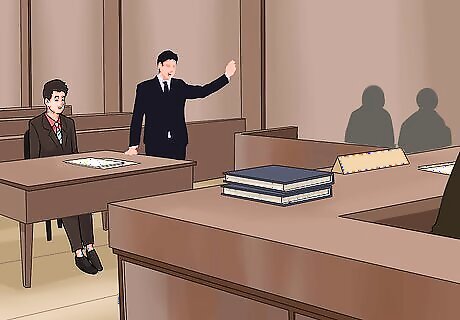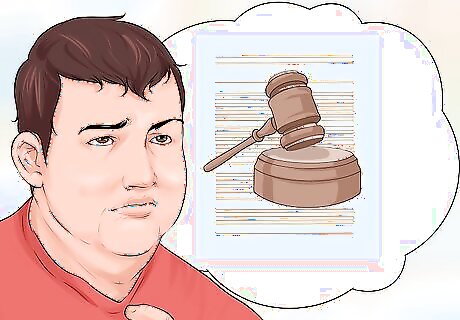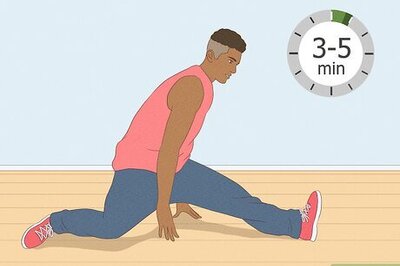
views
Gathering Evidence

Identify the private facts. When the plaintiff files a lawsuit, you will be sent a copy of the complaint. The complaint should identify the facts that you disclosed and how you disclosed them. Read the complaint carefully to identify the facts. If the plaintiff hasn’t yet sued you, you should still try to identify the facts the plaintiff objects to and how you published them. Private facts are intimate details which are not known widely. Information that is medical, sexual, or financial in nature typically qualifies.

Check that the complaint is sufficient. You can get a lawsuit dismissed if the plaintiff fails to allege sufficient facts. These required facts will vary somewhat, depending on your state law. However, a plaintiff must typically allege: you gave publicity to the fact the fact was private and not generally known the disclosure would be offensive to a reasonable person with ordinary sensibilities the fact was not newsworthy, i.e., not a matter of legitimate public concern

Read your state law. To find out what defenses you can raise, you should read your state law. Each state’s law is somewhat different; some states do not even allow plaintiffs to sue for this tort. To find your state law, you can search the Internet. Type “public disclosure of private facts” and then your state into your favorite web browser. The Digital Media Law Project has summaries of several state’s laws on its website.

Meet with a lawyer. A qualified attorney will be your best defense to a claim of public disclosure of private facts. A lawyer should be familiar with the most recent changes to the law. You can find a qualified attorney by calling your state’s bar association, which should have information on how to get a referral. You might be worried about costs. However, you should be aware that most states now allow lawyers to offer unbundled legal services. This means that you can hire a lawyer to perform only certain tasks, such as writing a motion for you or representing you in court. You would then do all other legal work yourself. When calling an attorney to set up a consultation, ask if they provide unbundled legal services. Reporters or editors should also call the Reporters Committee for Freedom of the Press, which runs a legal defense hotline, 1-800-336-4243. It is available 24 hours a day, seven days a week.

See if the private fact has already been disclosed. The information you published might have already been disclosed publicly, perhaps by the plaintiff. You should check the plaintiff’s social media accounts (Facebook, Instagram, etc.) to see if the fact has been published. Also look for blogs or websites the plaintiff maintains or posts on. If you can find that the fact has been disclosed, print off the applicable screens and preserve them.

Confirm that the fact was sufficiently offensive. A plaintiff cannot sue for any private fact disclosed. Instead, the law will allow a suit only if the fact would be offensive to a person with ordinary sensibilities. Typically, the following kinds of facts qualify as sufficiently offensive: someone nude in a bathtub video of two people engage in sexual activity

Check if the plaintiff consented. The plaintiff may have signed an interview release or model release form. Check through your papers to see if the plaintiff consented to the publication of the private information. Realize that minor children cannot consent on their own behalf. Instead, you would need a parent or guardian to consent. If the plaintiff consented but then revoked the consent, you do not have valid consent.
Crafting Your Defense

Raise affirmative defenses in your pleadings. Once you receive the complaint and summons, you will have a chance to respond by filing an answer. Look at the summons to see the deadline for filing your answer. In your answer, you will either admit, deny, or claim insufficient knowledge to admit or deny each fact alleged by the plaintiff. You can also raise affirmative defenses. These will differ by state, but generally you can raise: Consent. If the plaintiff consented to the publication of the private facts, then you have a complete defense. The lawsuit was filed too late. Each state has a statute of limitations which requires that a lawsuit be filed within a certain amount of time after the private fact was first published. If the plaintiff waited too long, you can have the case thrown out of court.

File your answer. You must file your answer with the court and serve a copy on the plaintiff. File in the same court that the plaintiff filed in. Make several copies of your answer and have the clerk stamp all of them. You need to give the plaintiff a copy of your answer. Ask the clerk for acceptable methods of service. Generally, you can mail a copy of your answer to the plaintiff or have a copy personally served by someone over the age of 18 who is not a party to the lawsuit. You might also be able to hire the sheriff or a private process server to make service. Typically, you must pay a fee.

Use discovery strategically. After you file your answer, the lawsuit enters the “discovery” stage. This is the fact-finding portion of the lawsuit. You and the plaintiff can request documents in the control or custody of each other. You can also ask questions of each other, whether in writing (using Interrogatories) or orally (in a deposition). You should use Interrogatories and depositions strategically. You should try to get the plaintiff to make admissions that you can use against him or her at trial. For example, a plaintiff can only recover damages for an injury he suffered. During a deposition, you should try to elicit information that shows the plaintiff has not suffered either physically or emotionally from the public disclosure of private facts. Also try to get the plaintiff to admit that she has publicly disclosed the private facts before. If you are not responsible for publicly spreading the private fact, then the plaintiff cannot sue you.

Bring a motion for summary judgment. At the close of discovery, you can bring a motion for summary judgment. This motion asks the court to decide the lawsuit in your favor without going to trial. In the motion, you argue that there are no disputed issues of fact and that you are entitled to win as a matter of law. You should have your lawyer draft the motion for summary judgment. This is a technical document that requires extensive legal research, which you probably cannot learn how to do on your own. If you lose your motion for summary judgment, then you will have to go to trial.

Come up with your trial strategy. You and your lawyer should discuss how you will defend yourself at trial. There are many defenses available. The evidence you need for trial will depend on the defense you present. You should come up with an outline of your defense before going to trial. For example, you might claim that the fact was already published publicly before you ever published it. For proof, you would need copies of emails or pages of websites. You might also use witnesses who have heard the plaintiff publicly spread the private information before. You might also argue that the person is a public figure and the private facts disclosed were therefore newsworthy. To prove this point, you could introduce newspaper or magazine articles showing that the person is well-known. Also, you could ask the witness questions. For example, on cross-examination you can get the witness to admit that he is running for public office. Information about public officials is typically newsworthy. You can also argue consent. Think about what evidence you have that the plaintiff consented to the disclosure. If you have notes or an email, then you will need to introduce those at trial. If the witness gave oral consent, identify any third parties who heard the plaintiff give consent and call that witness at trial.
Going to Trial

Arrive early. You might be nervous if you have never been to court before. Make sure to arrive early, giving yourself sufficient time to find parking and pass through any courthouse security. Try to get to the courtroom at least 15 minutes early. Don’t bring food or drinks into the courthouse and make sure that your cell phone is turned off. If you don’t know how to dress, see Dress for a Court Hearing for tips on appropriate attire.

Deliver an opening statement. In the opening statement, your lawyer will lay out what evidence you will prove. The purpose of the opening statement is not to overwhelm the judge or jury with facts but to provide a roadmap of the evidence and witnesses you will present. Effective opening statements are usually quite short—only fifteen minutes or so.

Cross examine the plaintiff’s witnesses. The plaintiff will present evidence and witnesses first. Your job, as the defendant, is to try and undermine the plaintiff’s witnesses by showing inconsistencies. You can do this in a couple of ways: Point out that the witness didn’t see or hear what she claimed. If a witness claimed to hear you publicly disclose a private fact in a crowded room, you can elicit testimony that the witness was actually on the other side of the room the entire night and couldn’t have heard you. Impeach the witness. You can use a prior inconsistent statement to undermine the witness’s credibility. This is where your deposition testimony comes in handy. For example, the plaintiff may claim at trial that she suffered severe emotional harm from the disclosure of the private facts. But you can then confront the witness with statements given in the deposition where she states her life hasn’t changed at all since the public disclosure.

Present your own witnesses. As the defendant, you present witnesses and evidence second. You will need to present whatever evidence supports your defense theory. You should let your attorney handle the examination and cross-examination of witnesses.

Make your closing arguments. At the end of the trial, you need to argue that you are entitled to win because the plaintiff has not proved by a preponderance of evidence that you are liable for public disclosure of private facts. “Preponderance” means “more likely than not.” Argue that the plaintiff did not make out her case. Look at the elements a plaintiff needs to prove to win this type of case: (1) public disclosure of (2) a private fact, (3) which would be offensive to a reasonable person, and (4) the fact was not newsworthy. You can attack each of these elements. Point out to the jury that the plaintiff never proved one of them. For example, you can ask the jury, “Where is the evidence that I published this fact? All she showed was that I sent an email to one friend mentioning it. That can’t be ‘public disclosure.’” Argue that you have proved an affirmative defense. You might have some evidence that the plaintiff orally consented to the publication. You can argue to the jury that the plaintiff consented and therefore you are relieved from liability. Even if the plaintiff proves each element of the claim, you would still win.

Appeal, if you lose. You have the right to appeal if you lose the lawsuit. You should discuss with your attorney whether or not this is a good option with you. Appeals generally take a year or more to resolve, and you might have to pay the court judgment even as you wait for the resolution of your appeal. Should you choose to appeal, then ask the court clerk for a Notice of Appeal form and fill it out. You have a limited amount of time to ask for an appeal (typically only 30 days), so you shouldn’t delay.




















Comments
0 comment